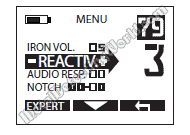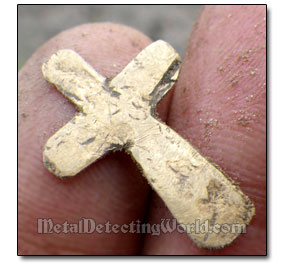XP Deus Program Settings, Features and Modes Explained, page 9
REACTIVITY: Function and Effects On Metal Detector's Performance
Levels: 0 to 5 (Page 13 in User's Manual)

Reactivity is a metal detector's recovery speed which reflects how fast it takes a metal detector to "recover" from responding to the last detected target before being able to respond to the next. The Deus' Reactivity of 1 represents the recovery speed of the majority of detectors on the market today.
Metal detectors with slow recovery speeds are not capable to respond to desired targets masked by rejected targets when Conventional Discrimination is used. For example, during a reactivity comparison test conducted with the XP Deus and Minelab E-Trac metal detectors, both machines were operated on program settings, including Conventional Discrimination, that would equal the detectors in performance. One exception was the Deus' Reactivity set at 3.
Four coins were placed three inches apart on a test board, and three medium-sized nails were placed between the coins. As I swung a search coil over the coins in one direction, the E-Trac gave a high-pitched response to only one coin, but the Deus gave a crisp, high-pitched response to each coin.
The Reactivity setting is the Deus' most important setting because it is responsible for both the quality of the detector's audio responses to "difficult" (partially masked) desirable targets and the Deus' detecting range.

Because the detector's depth penetration is always poor at the heavily iron-infested hunt sites, decent detecting range is out of question.
While metal detecting under such conditions, a user should enhance the Deus' ability to recognize good targets among bad ones - by means of setting the Reactivity reasonably high. In all other situations, the higher the Reactivity, the shorter the detecting range.
Just to see at what Reactivity level any particular coin induces the most clear audio response, you should air test the coin at different Reactivity levels. However, the most realistic audio responses, i.e. the closest to the real ones in a field, can only be obtained through testing at the specially constructed Test Garden.

At any hunt site, the Reactivity level should be set according to a level of iron content in soil and types of targets sought. If the hunt site is heavily contaminated with iron junk, the Reactivity level should be high to enable the Deus to respond to good targets lying next to bad ones.
However, the detector's responses to small and tiny coins will be shortened or, worse, "clipped" if the Reactivity level is set higher than 2. At 1, the audio responses to the partially masked coins would be blended into the low-pitched iron signals - "keep walking" signals.
To sum up, lowering the Reactivity will ensure increasing the Deus' detecting range; 2-3 inches between adjacent levels being a difference.
Lower Reactivity produces smoother responses to targets and appears to considerably reduce effects of EMI (Electro Magnetic Interference). However, the lower the Reactivity, the lower an amount of high-pitched responses to the partially masked targets.
If the Reactivity is set high, responses to small- and medium-sized coins become too short, like audio "ticks". And a certain 'Search Coil Wiggling' technique (described in Part II) is especially required to isolate audio responses to the partially masked coins.
NOTE: In the v3.0 and subsequent versions, the Reactivity feature got an enhanced ability to distinguish between good targets, iron and ground mineralization. For example, with the Reactivity setting at 3, you will obtain target separation similar to the Reactivity set at 4 in version v2.0.
The Reactivity 4 and 5 settings will provide even greater target separation (pages 13-14 of the Deus v3.0 User's Manual); however, the Deus' responses to small targets (both masked and not masked by iron) should be tested with the improved Reactivity feature to determine and prevent its undesirable effect such as the detector's response to a small target being too short to be noticed or classified as "good".